by Ngọc Thanh
Fifty years on, the heroic Second Battle of Quảng Trị is much remembered. The battle, sometimes named Operation Lam Sơn 72, raged for 81 days from June 28 to September 16, 1972.
The sacrifices made by the Việt Nam People’s Army against the American-backed Sài Gòn troops remain a source of overwhelming pride to locals to this day.
Protecting the ancient citadel
In 1966, 13-year-old Nguyễn Thanh Bình left his hometown in Giang Phao Village, Gio Linh District of the north-central province of Quảng Trị to evacuate further north with over 30,000 other pupils from Quảng Bình and Quảng Trị provinces.
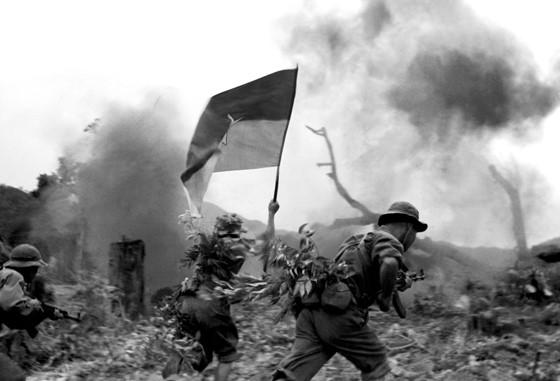
Fierce attacks by the enemy did not scare the Việt Nam People's Army. — VNA/VNS File Photo
Bình lived with residents in Định Long Commune in the province of Thanh Hóa.
When he finished seventh grade in January 1972, Bình volunteered to join the army and was sent to Quảng Bình for training. In June, he was assigned to fight in Quảng Trị Citadel.
He joined Battalion 8 and marched to the citadel, where they rushed to build trenches and outposts to be ready for Operation Lam Sơn 72.
After Battalion 8, Regiment 48 of Division 320 arrived in the area to station at La Vang and Tri Bưu An Tiêm.
Previously, on May 1, 1972, Quảng Trị was liberated from the US-Sài Gòn troops, which changed the situation of the American strategy in the war and created an impetus for the liberation of the south.
On July 20, 1954, the Geneva Accords which brought peace to Indochina were signed, temporarily dividing Việt Nam into two parts, pending general elections.
The northern part of Quảng Trị from Bến Hải River upward was administered by the Democratic Republic of Việt Nam, while the southern part from Gio Linh District downward was controlled by the Sài Gòn administration.
Quảng Trị Town, including Quảng Trị Ancient Citadel, became an important military, political and socio-political centre for the Sài Gòn administration.
The southern regime considered the Quảng Trị defence system a stable dyke preventing northern attacks. Yet after the Spring-Summer Campaign between March 30 and May 1, 1972, the Việt Nam People's Army took back a large area from Bến Hải River to Mỹ Chánh and Khe Sanh to Cửa Việt.
The Sài Gòn regime wanted to take it back.
81 burning days & nights
On June 28, US-backed Sài Gòn troops moved to Lam Sơn, passing Mỹ Chánh River, advancing along National Highway 1A to Quảng Trị Town.
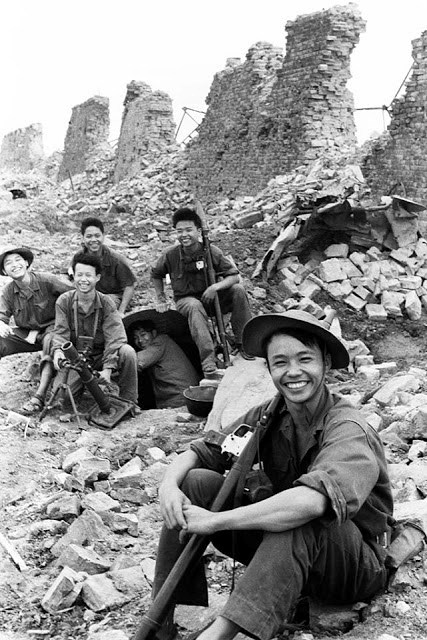
Bright smiles of soldiers at Quảng Trị Ancient Citadel, a popular photo by journalist Đoàn Công Tính. — VNA/VNS File Photo
The two most powerful divisions, the Marine Division and Airborne Division, supported by the Rangers Corps of the Sài Gòn regime were mobilised for this battle. The troops were fully equipped with modern tanks, airplanes and heavy artillery.
On July 3, the enemy marched to Long Hưng Junction, in today’s Hải Phú Commune, Hải Lăng District, bordering Quảng Trị Town. In the first battle, 100 Sài Gòn soldiers were killed, and five tanks were destroyed.
In the following days, the Sài Gòn troops continued to attack with heavy firepower.
Veteran Nguyễn Văn Bình, now 68, recalls the horror: "To be honest, we – the new recruits – were terrified the first few days. Then we got used to that and patiently fought back, trying to take back each house, each metre of land without fearing death.”
Acting as a local scout, Bình continuously travelled around the area to get information about the enemy and report it to the command. He understood the severity of the situation.
In the first days, he said the enemy shot some 500 artillery shells at Quảng Trị Town, without mentioning hundreds of bombs from aircraft. When under counterattacks from the North Việt Nam army, the enemy doubled their firepower.
“Though we seriously suffered, we are determined to fight without any fear,” Bình said.
Cao Xuân Ý, another veteran who is now residing in Quảng Trị Town, was a soldier of Battalion 808 of the Quảng Trị provincial army.
Ý remembered how the night sky at the Quảng Trị Citadel was lit up as if it were daytime by artillery and bomb explosions. At other times the whole sky would turn a fiery red.
After crossing Thạch Hãn River, he and his comrades quickly dug a shelter in the night, to be ready to fight in early morning the next.
“Each shelter hosted three men, we shot whenever we saw enemy,” Ý said. “We barely had a single minute’s break.”
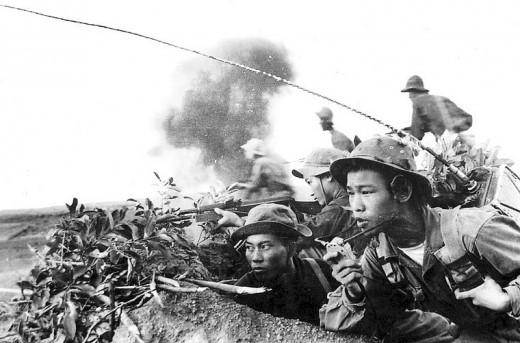
The Việt Nam People's Air Force, for the first time, shot down a B-52 bomber of the US Air Force in Quảng Trị. — VNA/VNS File Photo
“At night, the team on the ground looked for bomb craters to find some water to take to the shelter. We soaked dried rice in water to eat. We had no choice. It didn’t matter if the water was not clean. We just ate the rice.
“Sometimes, the enemy launched attacks even when we were eating. So we had to cancel our meal to fight. Even bathing was a luxury back then.”
Between July 10 and 24, the North’s army on the battle field was reinforced with Battalion 3 Tam Đảo, Battalion 4, Battalion 5 and Battalion 6 (of Regiment 95).
Nguyễn Thị Thu, a resident in Triệu Phong District, said she was then nearly 18. She followed her father-in-law Nguyễn Con to row a boat to carry the North's troops to cross the Thạch Hãn River whenever the enemy stopped shelling.
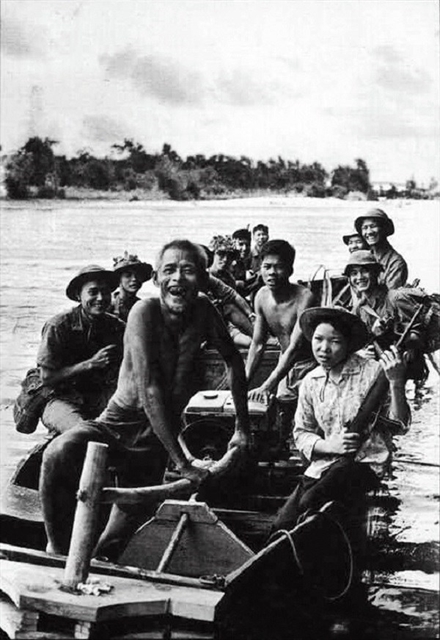
A local fisherman and his daughter carry soldiers on their boat crossing the Thạch Hãn River to the Quảng Trị Ancient Citadel in 1972. — VNA/VNS File Photo
“Crossing the river was highly dangerous,” she said. “Many soldiers were shot together with rowers. Their blood mingled with the river water, which turned red.”
Soldiers died. New soldiers came. The scale of the bloodshed was terrifying.
Thu tried to remember just how many soldiers she had transported to the ancient citadel and how many injured soldiers she brought back from the front.
With the ambition to take back Quảng Trị's ancient citadel, Nguyễn Văn Thiệu, president of South Việt Nam, three times boasted of his troops hoisting the Sài Gòn flag over the citadel (on July 13, 15 and 20), but each time it was taken down by the North Vietnamese army.
It was reported that the Sài Gòn troops shot over 30,000 artillery shells at the town and ancient citadel.
In early September 1972, heavy rains flooded the Thạch Hãn River and the North army's trenches. Transport of food and weapons almost became stuck while the enemy made significant attacks resulting in severe losses for the North Vietnamese army.
“At many stations, our soldiers were almost submerged by water in the trenches,” Bình said. “We ate dried rice soaked in water and other dried provisions. Conditions were terrible.”
When the enemy nearly reached the citadel, the number of the North Vietnamese soldiers was too few. From 8pm on September 15, they withdrew to north of the Thạch Hãn River. By 2pm on September 16, the rest of the North Vietnamese troops ended the stubborn fight to protect Quảng Trị Ancient Citadel. They lost the battle but would soon go on to win the war.
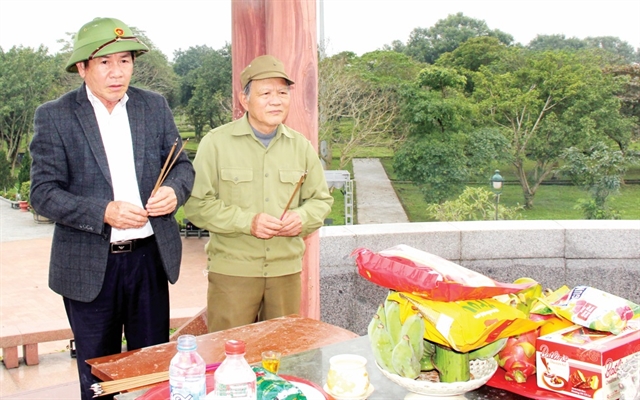
Veterans Thái Quang Thanh (left) and Nguyễn Văn Bình pray for their fallen comrades at the citadel. — VNA/VNS Photo
During the 81 days of fierce fighting, the area would suffer from 328,000 tonnes of bombs and shells, equivalent to 100 tonnes of bombs and 200 artillery shells for every single soldier of the North Vietnamese army.
Fifty years on from liberation day, Quảng Trị Town is no longer full of death but full of life. A bustling area has risen from the ashes.
Veterans such as Bình and Ý keep a routine to burn incense for the souls of their fallen comrades at the citadel on the first and 15th day of a lunar month, as well as on other important events. To this day, they still search for the remains of dead soldiers in the citadel.
In memory of the fallen soldiers and of the sacrifices of all who fought so bravely, Bình has planted 81 bonsai trees in the citadel, one for every day of the bloody battle. VNS

Veteran Lê Xuân Ý holds a photo of him meeting his old comrades. — VNA/VNS Photo
OVietnam